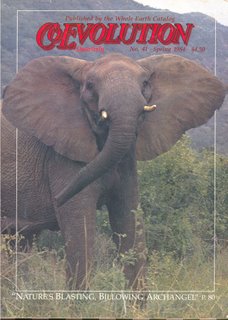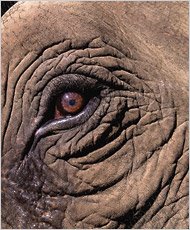Nature's blasting, billowing Archangel
 At first I couldn't quite figure out why I was particularly moved after reading the cover story in the October 8, 2006 issue of the Sunday New York Times Magazine entitled "Are We Driving Elephants Crazy"(I mean, beside the fact that it is a well-written piece on a disturbing topic). Then I remembered something I'd read 22 years ago in CoEvolution Quarterly. It was simply entitled "Elephants", written by English playwright-actor-poet Heathcote Williams.
At first I couldn't quite figure out why I was particularly moved after reading the cover story in the October 8, 2006 issue of the Sunday New York Times Magazine entitled "Are We Driving Elephants Crazy"(I mean, beside the fact that it is a well-written piece on a disturbing topic). Then I remembered something I'd read 22 years ago in CoEvolution Quarterly. It was simply entitled "Elephants", written by English playwright-actor-poet Heathcote Williams.I'm a hoarder when it comes to books and old magazines. I still have the issue: No. 41; Spring 1984, dedicated to "Nature's Blasting, Billowing Archangel". Rereading the article reminded me of just how special these creatures are.
Following are a few passages from "Elephants":
On the night of the birth of the Buddha
An elephant entered the dreams of Queen Mahamaya, his mother...
And Guatama Buddha was consequently patient, strong, meek
And unforgetful.
The oldest and largest of land mammals
Was born in the late Ice Age
While we were only a glint in Darwin's eye.
The shape of an African elephant's ear
Is the shape of Africa;
The Shape of an Indian elephant's ear
Is the shape of India...
Almost as if Nature had kept an ear to the ground, when listening to the elephant's territorial requests.
Elephants walk on the tips of their toes.
Elephant paths in the Congo Basin mountains are near-vertical.
They can move in total silence without leaving a trace.
They wash, massage and powder their quilted skin with fine dust, daily,
And their surface muscles are so cunningly tuned
That they can crush a colony of Haematomyzus (elephant lice)
With one focused ripple.
An elephant's birth is attended by two or three midwives
In the center of a protective circle.
The elephant's child then enters a matriarchal, communal society
With breast milk available at every street corner.
They seem to regard the human landscape
With a dynamic disdain:
When they've a mind to
They'll turn over Hamburger stands,
Crush and grind Rangerovers,
Uproot telephone poles,
Smash down game reserve fencing
(Despite its being constructed of steel railroad tracks)
To them,
We may be a clumsy, ludicrous and insensitive
White rogue elephant.
They will altruistically remove stricken fellows
Out of the line of fire.
They will nudge and nurse the wounded to their feet.
They have been know to practice mercy killing.
And they bury their dead,
By covering them with mud, earth, leaves and branches;
Then return later to draw the tusks
Removing them several miles away,
Or seizing them and shattering them against a nearby tree,
As if to cheat poachers and traders
Bereaved herds have even raided the warehouses of ivory salesmen
To restore missing components to a dead companion.
While the integrity of their life has been invaded,
They attempt to preserve the integrity of their death.
(GW)
 An Elephant Crackup?
An Elephant Crackup?By Charles Siebert
New York Times
All across Africa, India and parts of Southeast Asia, from within and around whatever patches and corridors of their natural habitat remain, elephants have been striking out, destroying villages and crops, attacking and killing human beings. In fact, these attacks have become so commonplace that a new statistical category, known as Human-Elephant Conflict, or H.E.C., was created by elephant researchers in the mid-1990’s to monitor the problem. In the Indian state of Jharkhand near the western border of Bangladesh, 300 people were killed by elephants between 2000 and 2004. In the past 12 years, elephants have killed 605 people in Assam, a state in northeastern India, 239 of them since 2001; 265 elephants have died in that same period, the majority of them as a result of retaliation by angry villagers, who have used everything from poison-tipped arrows to laced food to exact their revenge. In Africa, reports of human-elephant conflicts appear almost daily, from Zambia to Tanzania, from Uganda to Sierra Leone, where 300 villagers evacuated their homes last year because of unprovoked elephant attacks.
Still, it is not only the increasing number of these incidents that is causing alarm but also the singular perversity — for want of a less anthropocentric term — of recent elephant aggression. Since the early 1990’s, for example, young male elephants in Pilanesberg National Park and the Hluhluwe-Umfolozi Game Reserve in South Africa have been raping and killing rhinoceroses; this abnormal behavior, according to a 2001 study in the journal Pachyderm, has been reported in ‘‘a number of reserves’’ in the region. In July of last year, officials in Pilanesberg shot three young male elephants who were responsible for the killings of 63 rhinos, as well as attacks on people in safari vehicles. In Addo Elephant National Park, also in South Africa, up to 90 percent of male elephant deaths are now attributable to other male elephants, compared with a rate of 6 percent in more stable elephant communities.
In a coming book on this phenomenon, Gay Bradshaw, a psychologist at the environmental-sciences program at Oregon State University, notes that in India, where the elephant has long been regarded as a deity, a recent headline in a leading newspaper warned, ‘‘To Avoid Confrontation, Don’t Worship Elephants.’’ ‘‘Everybody pretty much agrees that the relationship between elephants and people has dramatically changed,’’ Bradshaw told me recently. ‘‘What we are seeing today is extraordinary. Where for centuries humans and elephants lived in relatively peaceful coexistence, there is now hostility and violence. Now, I use the term ‘violence’ because of the intentionality associated with it, both in the aggression of humans and, at times, the recently observed behavior of elephants.’’
For a number of biologists and ethologists who have spent their careers studying elephant behavior, the attacks have become so abnormal in both number and kind that they can no longer be attributed entirely to the customary factors. Typically, elephant researchers have cited, as a cause of aggression, the high levels of testosterone in newly matured male elephants or the competition for land and resources between elephants and humans. But in ‘‘Elephant Breakdown,’’ a 2005 essay in the journal Nature, Bradshaw and several colleagues argued that today’s elephant populations are suffering from a form of chronic stress, a kind of species-wide trauma. Decades of poaching and culling and habitat loss, they claim, have so disrupted the intricate web of familial and societal relations by which young elephants have traditionally been raised in the wild, and by which established elephant herds are governed, that what we are now witnessing is nothing less than a precipitous collapse of elephant culture.
It has long been apparent that every large, land-based animal on this planet is ultimately fighting a losing battle with humankind. And yet entirely befitting of an animal with such a highly developed sensibility, a deep-rooted sense of family and, yes, such a good long-term memory, the elephant is not going out quietly. It is not leaving without making some kind of statement, one to which scientists from a variety of disciplines, including human psychology, are now beginning to pay close attention.
Click here to read the entire New York Times Magazine article.


0 Comments:
Post a Comment
<< Home